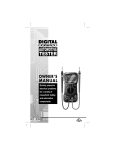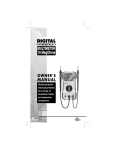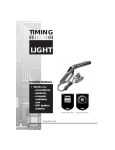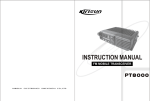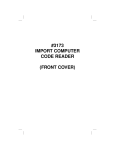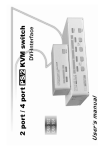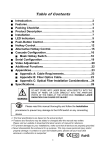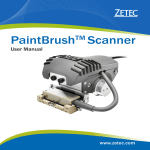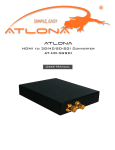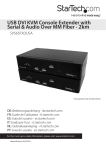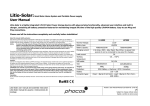Download 3660 HAND PUMP
Transcript
FRONT COVER 3660 HAND PUMP 3660 © Innova 2001 Paragraph I II III IV V VI VII VIII IX X XI XII XIII XIV Title Page No. INTRODUCTION............................................................ SAFETY PRECAUTIONS .............................................. VEHICLE SERVICE MANUALS................................... UNDERSTANDING VACUUM SYSTEMS ................... AUTOMOTIVE VACUUM SYSTEMS ........................... VACUUM MOTOR/ACTUATOR OPERATION AND TESTING................................................................ TESTING THE PCV SYSTEM ....................................... TESTING THE EGR SYSTEM....................................... DIAGNOSING MECHANICAL ENGINE CONDITIONS ................................................. EXHAUST SYSTEM RESTRICTION TEST ................. FLUID EVACUATION ................................................... BLEEDING BRAKES ..................................................... REPLACEMENT PARTS .............................................. SERVICE PROCEDURES ............................................. 1 1 2 2 4 7 8 10 13 15 16 18 20 21 WARNING: This manual includes WARNINGS and CAUTIONS identifying procedures and practices which, if not performed properly, may result in personal injury or equipment damage. However, this manual DOES NOT cover all possible uses or methods of operation for the hand pump. It is the responsibility of the user to determine that the method of operation and/or servicing procedure used will not jeopardize personal safety or vehicle safety. DO NOT USE THE VACUUM PUMP, IN ANY MANNER, ON THE HUMAN BODY. i 3660 I. INTRODUCTION Congratulations. You have purchased a precision instrument manufactured to the highest quality standards. This hand-operated vacuum pump is a versatile tool that can be used in almost any application where a vacuum must be generated, an existing vacuum within a system must be measured or for fluid evacuation. The vacuum pump is designed to aid in testing automotive vacuum systems; testing vacuum actuated components and devices, and bleeding brake systems. The vacuum pump can also be used (in conjunction with a fluid evacuation kit) as a fluid evacuation device to evacuate fluids from various systems or locations. II. SAFETY PRECAUTIONS To avoid personal injury, instrument damage and/or damage to equipment under test, DO NOT operate the hand pump before reading this manual. ALWAYS use extreme caution when working on an automobile. This manual describes common test procedures used by experienced service personnel and technicians. Many test procedures require precautions to avoid accidents that can result in personal injury, and/or vehicle or equipment damage. Always read your vehicle's service manual and follow its safety precautions before any test or service procedure is performed. 3660 a. When an engine is running, it produces carbon monoxide )a toxic and poisonous gas). To prevent serious injury or death from carbon monoxide poisoning, operate a vehicle ONLY in a well-ventilated area. b. To protect your eyes from propelled objects as well as hot or caustic liquids, always wear approved safety eye protection. c. When an engine is running, several engine components rotate at a very high rate of speed (coolant fan, pulleys, fan belt etc.). To avoid serious injury, always be conscious of moving parts and keep a safe distance from all these items as well as other potentially moving objects. d. Engine parts become extremely hot when the engine is running. To prevent severe burns, avoid contact with hot engine parts. e. Before starting an engine for troubleshooting, make sure the parking brake is engaged. Put the transmission in "park" )for automatic transmission) or "neutral" (for manual transmission). Block the drive wheels with a suitable blocking device. 1 III. f. To prevent damage to the on-board computer when taking vehicle electrical measurements, always use a digital multimeter with at least 10 Megohms of impedance. g. The vehicle's battery produces highly flammable hydrogen gas. To prevent an explosion, keep all sparks, high temperature items and open flames away from the battery. h. Don't wear loose clothing or jewelry when working on an engine. Loose clothing can get caught on the fan, pulleys, belts, etc. Jewelry is highly conductive to electricity, and can cause a severe burn if it makes contact between a power source and ground. VEHICLE SERVICE MANUALS It is recommended that you consult the manufacturer’s service manual for your vehicle before any test or repair procedures are performed. Contact your local car dealership or auto parts store for availability of these manuals. The following companies publish valuable repair manuals. Haynes Publications, 861 Lawrence Drive, Newbury Park, CA 91320, Phone: CA (800) 442-9637, TN (800) 242-4637 Motor Publications, 5600 Crooks Road, Suite 200, Troy, Michigan 48098, Phone (800) 426-6867 Mitchell International, 14145 Danielson Street, Poway, CA 92064, Phone (888) 724-6742 FACTORY SOURCE (Ford, GM, Chrysler, Honda, Isuzu, Hyundai and Subaru Service Manuals Helm Inc., 14310 Hamilton Avenue, Highland Park, Michigan 48203, Phone (800) 782-4356 IV. UNDERSTANDING VACUUM SYSTEMS In order to properly test and diagnose faults in automotive vacuum systems, it is important to understand what vacuum is, how it is measured, and how engines create, distribute and use vacuum. A. WHAT IS VACUUM? The earth’s atmosphere (the air that we breathe) is not really empty space, but is filled with air molecules. Vacuum is the partial or complete absence of atmosphere (an empty space where no molecules of any sort exist). Interstellar space is an almost a perfect vacuum. 2 3660 B. HOW IS VACUUM MEASURED? The earth’s atmosphere exerts a force on all surfaces it contacts. This force is called “atmospheric pressure”. There is a direct relationship between atmospheric pressure and vacuum. In order to understand vacuum, we need to understand what atmospheric pressure is and how it's measured. Air is composed of tiny particles called molecules. Air molecules have weight. Atmospheric pressure is defined as the force exerted by the total weight of the air above a specific area at any elevation. At sea level, the total weight of a column of air (air molecules) above an area of one square inch equals 14.7 pounds (1030g/cm2). At higher elevations there are fewer air molecules, and the weight of the air above a comparable surface area is lower than at sea level. This is why the air pressure at higher elevations is lower than at sea level. Atmospheric pressure is measured using an instrument called a Manometer/Barometer. A Manometer/Barometer is a hollow glass tube with one end sealed and the other end immersed in a container of mercury. At sea level, the force of the surrounding air pressure (atmospheric pressure) of 14.7 psi (1030g/cm2) acting on the mercury in the container forces the mercury up the glass tube to a measured height of 30 inches (76 cm). Vacuum can be defined as a pressure that is less than the surrounding air pressure (atmospheric pressure). Vacuum gauges base their readings on atmospheric pressure as indicated on a Manometer/ Barometer. The “0” indication on a vacuum gauge is calibrated to represent "atmospheric pressure"; the “30” indication represents "zero pressure" or a "perfect vacuum". Any reading between these two indications (“0” and “30”) represents a pressure that is less than the surrounding air pressure (atmospheric pressure). C. HOW IS VACUUM CREATED/GENERATED? Vacuum (a low pressure area) can be created in a sealed container in one of two ways: 3660 1. If part of the air is removed from a sealed container, there will be fewer air molecules per square inch inside the sealed container than in the surrounding outside air. Fewer air molecules within a constant area equates to a lower air pressure. 2. If the area inside a sealed container is increased but the amount of air inside the container stays the same. The area inside the container will have fewer air molecules per square inch than the surrounding outside air. Increasing area while maintaining a constant volume of air equates to a lower air pressure. 3 V. AUTOMOTIVE VACUUM SYSTEMS A. HOW AN ENGINE GENERATES VACUUM Gasoline engines create vacuum as a byproduct of normal operating. During engine operation, when the pistons inside the cylinders move down on the intake stroke, the combustion chamber area (volume) inside the cylinders is greatly increased (see Figure 1). This action decreases the pressure inside the combustion chamber creating a partial void or vacuum (an area with fewer air molecules per square inch than the surrounding outside air.) A mixture of air and fuel from the carburetor/fuel injectors and intake manifold rushes into the cylinders through the intake valve to fill this partial void. The continuous movement of the pistons within the cylinders creates a need for a constant supply of air and fuel to fill the partial void created inside the cylinders on the intake strokes. The continuous flow of air and fuel through the intake manifold creates a low pressure (vacuum) inside the manifold. The low pressure (vacuum) in the intake manifold exists as long as the engine is in operation. This is how vacuum is generated in an internal combustion (gasoline) engine. FUEL INJECTOR VACUUM PORT EXHAUST INTAKE MANIFOLD COMBUSTION CHAMBER PISTON Figure 1. Piston Intake Stroke In a gasoline-operated engine/vehicle the vacuum that is generated in the intake manifold is used to operate a number of vacuum-actuated or vacuum-controlled devices. NOTE: Diesel engines, because of their design, produce less vacuum than gasoline engines. The vacuum produced by a diesel engine is insufficient to operate vacuum devices. If vacuum devices are added to a diesel system, an electrical or mechanical vacuum pump is used to operate these devices. Regardless of how vacuum is generated, the principle of operation of vacuum devices is the same. The hand vacuum pump can be used to test vacuum operated devices on both gasoline and Diesel systems. 4 3660 B. VACUUM DISTRIBUTION SYSTEMS In order to supply vacuum from the intake manifold to the various vacuum-operated devices found on an automobile, a vacuum distribution system is needed. Vehicle manufacturers install vacuum ports and/or vacuum distribution blocks in the intake manifold. Most vacuum-operated devices are connected to these vacuum ports/vacuum distribution blocks using vacuum hoses, lines and fittings. NOTE: Some vacuum ports are located above the throttle plates of the throttle body and only supply vacuum when the throttle plates open. This type of connection is called "Ported Vacuum". On some vehicles, emission-related devices such as EGR valves or distributor vacuum actuators are designed to operate only when the vehicle is driven under certain conditions. Ported vacuum is used to operate these devices. C. USING THE VACUUM PUMP The vacuum pump consists essentially of a pump body, a moveable handle, a spring-loaded piston rod, a vacuum gauge, a vacuum fitting and a vacuum release system (see Figure 2). GAUGE FILTER MAIN BODY SPRING PUMP HANDLE VACUUM PORT PISTON ASSEMBLY VACUUM RELIEF VALVE Figure 2. Hand Vacuum Pump - Exploded View The vacuum pump can be used in almost any application where vacuum must be generated, or where existing vacuum within a system must be measured. In most cases, the vacuum pump is connected directly to the vacuum port of a component, or is connected into a vacuum hose in the system using a tee connector. The following paragraphs outline the basic modes of operation for the vacuum pump. Specific uses for the vacuum pump are provided later in this manual. 3660 5 D. APPLYING VACUUM 1. Connect the vacuum pump's vacuum fitting to the component or system to be tested. 2. Squeeze and release the pump handle, and read the amount of vacuum indicated on the vacuum gauge. 3. Continue squeezing and releasing the pump handle until the desired amount of vacuum is shown on the vacuum gauge. E. TROUBLESHOOTING VACUUM SYSTEMS NOTE: This manual describes common general test procedures used by service personnel and technicians. Use the test procedures described in this manual only as a guide. Always consult the vehicle's service manual for more detailed testing instructions and specifications before any diagnostic test or procedure is performed. The intake manifold is a sealed system, and the air that enters the system must be metered to maintain a balanced air/fuel mixture. On a gasoline engine, this metering is controlled by the throttle plates. A leak in any part of the vacuum system, including the intake manifold, introduces unmetered air into the intake manifold, resulting in a leaner air/fuel mixture (too much air/not enough fuel). A lean air/fuel mixture can result in higher combustion temperature and engine misfires. A vacuum leak will also reduce the total amount of vacuum available to all vacuum-operated devices, and may severely effect their operation. The following are some possible symptoms/results of a vacuum leak: • Rough or uneven idle • Stalling • Pinging or knocking • Burned spark plugs • Burned exhaust valves • Faulty operation of vacuum-operated devices F. TESTING AND CHECKING VACUUM DEVICES AND COMPONENTS Most problems in automobile vacuum systems result from disconnected or leaking hoses, bad connectors, defective motor diaphragms or valves. Pinched vacuum hoses or clogged valves may also restrict vacuum flow. The first step in checking a vacuum system is to visually check all vacuum hoses, lines and connectors for cuts, cracks and splits. Check for collapsed or pinched vacuum hoses. Vacuum hoses have a tendency to deteriorate because of harsh conditions within the engine compartment. 6 3660 VI. VACUUM MOTOR/ACTUATOR OPERATION AND TESTING A. VACUUM MOTOR/ACTUATOR DESCRIPTION AND OPERATION A vacuum motor/actuator is a device that uses vacuum to perform a mechanical function. An automobile engine uses vacuum motors/ actuators to perform many functions. Typical functions performed by vacuum motors/actuators are: • Opening and closing the heater and air conditioning duct doors • Raising the EGR valve pintle off it’s seat to recirculate exhaust gas back into the system • Activating the vacuum advance unit to advance distributor spark advance timing A vacuum motor/actuator is a partially sealed container (on VACUUM PORT most vehicles container is cylindrical in shape). One side SPRING of the container is sealed, and is equipped with a vacuum port. The other side of the container is covered by a DIAPHRAM rubber diaphragm, or a piston a spring, with an attached shaft or a lever. When engine vacuum is applied to the container's vacuum port, a partial vacuum (lower than LEVER atmospheric pressure) is created in the sealed section of the container. As a result, atmospheric pressure exerts a Figure 3. Typical Vacuum force on the side of the piston Motor/Actuator or diaphragm that is open to the atmosphere, causing it to move in the direction of the applied vacuum. This mechanical action is is utilized to activate whatever is attached to the shaft or lever on the diaphragm (see Figure 3). The amount of force applied by atmospheric pressure to the diaphragm is calculated by multiplying the pressure difference between atmospheric pressure and the pressure within the container times the surface area of the diaphragm or piston: Atmospheric Pressure Container Pressure X Surface area = Force The hand vacuum pump can be used to perform a wide range of tests such as measuring the amount of vacuum in a system or device, detecting a leak in a system or a fluctuating vacuum supply. The pump can also be used for testing the function of a variety of vacuumoperated devices. 3660 7 B. VACUUM MOTOR/ACTUATOR TESTING PROCEDURES The following procedure shows how the vacuum pump might be used to check a vacuum motor/actuator for a leaking diaphragm: 1. Connect the vacuum pump's vacuum hose to the vacuum port of the motor/actuator. 2. Operate the handle to apply 8-10 inches (20-25 cm) Hg of vacuum to the motor/actuator, as shown on the vacuum gauge. NOTE: Consult the vehicle’s service manual for specifications. 3. Observe the vacuum gauge for approximately one minute. • If the vacuum gauge reading remains steady for one minute, the diaphragm is not leaking. • If the vacuum gauge reading falls, a leaking diaphragm is indicated. VII. TESTING THE PCV SYSTEM A. SYSTEM DESCRIPTION AND OPERATION The Positive Crankcase Ventilation (PCV) system helps reduce air pollution by aiding in the scavenging and burning of harmful engine crankcase vapors and gases before they can enter the atmosphere. The PCV system consists essentially of an intake filter, PCV valve and interconnecting hoses (see Figure 4). Fresh air is drawn through the intake filter (located in the air cleaner), through the valve cover, and into the crankcase to be mixed with the crankcase gases. From the crankcase the gases are drawn to the opposite valve cover, through the PCV valve, and into the intake manifold. The intake manifold vacuum draws these crankcase gases where they are mixed with incoming intake air to be burned during engine combustion. Airflow through the PCV system adds to the airflow through the carburetor or throttle body during engine operation. During cruising and light acceleration, intake manifold vacuum and the pressure inside the crankcase are relatively high. The strong manifold vacuum draws the PCV valve plunger into the narrow end of the valve, restricting most of the flow of gases into the intake manifold. During hard acceleration or high speed operation (heavy load condition), low intake manifold vacuum allows the PCV valve spring to overcome the high crankcase pressure, pushing the plunger out of the narrow end of the PCV valve and increasing the flow of crankcase gases into the engine for combustion. 8 3660 TYPICAL PCV SYSTEM / PCV VALVE OPERATION FRESH AIR (CLOSURE) TUBE OIL FILLER CAP 3 AIR CLEANER CARB. INT. MAN. ROCKER COVER PCV VALVE CONTROLS FLOW RATE CRANK CASE 1 OIL SEPARATOR FRESH AIR FLOW 2 AIR AND CRANKCASE VAPOR FLOW PCV VALVE OPERATING CONDITIONS NORMAL HIGH SPEED OR LOAD HIGH VACUUM PULLS VALVE TOWARD TOP SEAT FLOW RATE IS LOW BACKFIRE DURING CRANKING BACKFIRE CAUSES HIGH PRESSURE IN MANIFOLD VACUUM IS LOW FLOW RATE INCREASES SPRING OPENS VALVE FARTHER PLUNGER SEATS TO SEAL OFF FROM CRANKCASE CRANKCASE PRESSURE TENDS TO CLOSE VALVE Figure 4. Typical PCV System / PCV Valve Operation B. TEST PROCEDURES As a result of normal engine operation, the PCV valve may become clogged and reduce the amount of crankcase ventilation. Reduced ventilation can cause the formation of acids in the crankcase, and a buildup of pressure which could force engine oil out past the engine seals. To prevent these problems, the PCV valve should be replaced periodically. NOTE: A slow or rough idle can be caused by a clogged PCV valve. Check the PCV system BEFORE adjusting engine idle. 3660 9 1. Inspect the PCV system for worn, kinked or plugged hoses. Make sure all hoses are properly and securely connected. 2. Connect the hand vacuum pump to an intake manifold vacuum port. (use the hose and a suitable adapter from the accessory kit, as needed). 3. Start and run the engine until it reaches normal operating temperature. 4. Run the engine at idle and observe the vacuum gauge. 5. • The vacuum gauge should indicate between 16 ~ 22 in. (41 ~ 56 cm) Hg. • • The gauge needle should remain steady (little or no movement). • Engine speed should decrease by approximately 100 RPM (as a result of loss of air flow from the PCV system). • Vacuum should increase slightly (indicating vacuum flow through the PCV system has been plugged). Note the engine speed (RPM) and vacuum at idle. Clamp the vacuum supply hose to the PCV valve. • If BOTH a decrease in engine RPM and an increase in vacuum are not observed, replace the PCV valve and/or any damaged or plugged hoses. NOTE: Be sure to install the correct PCV valve for your vehicle. Installing the wrong PCV valve can result in either excessive or insufficient air flow through the PCV system. 5. After replacing the PCV valve, ALWAYS readjust the engine's idle speed and, if possible, the idle air/fuel mixture. Refer to your vehicle's service manual for procedures. NOTE: On some vehicles idle speed and air/fuel mixture are not adjustable. The on-board computer makes adjustments based on sensor inputs and engine operating conditions. ALWAYS consult the vehicle's service manual before making any adjustments. VIII. TESTING THE EGR SYSTEM A. SYSTEM OPERATION The Exhaust Gas Recirculation (EGR) system is used to reduce Oxides of Nitrogen (NOx) emissions. NOx is created when nitrogen and oxygen in the atmosphere mix at temperatures above 2,500F° (1371° C). During combustion, temperatures in the cylinders can exceed 3,500 F° (1927° C), providing ideal conditions for the formation of NOx. The EGR system reduces the formation of NOx by lowering the combustion temperature. This is accomplished by recirculating exhaust gases through an EGR valve back into the combustion chambers. 10 3660 Depending on the make, model and year of your vehicle, the EGR valve may be controlled by one of two methods (see Figure 5): VACUUM PORT SEALED HOUSING SPRING INTAKE FLOW ACTUATING ROD DIAPHRAGM EGR FLOW THROTTLE PLATE EXAUST FLOW Figure 5. Typical EGR System Operation • Ported Vacuum - The EGR valve is actuated by ported vacuum from above the carburetor's throttle plates. The amount of exhaust gas that is recirculated back into the combustion chamber depends on the amount of vacuum that reaches the EGR valve. At idle and at wide open throttle a negligible amount of vacuum reaches the valve and the valve stays closed. As the throttle plates gradually open, vacuum reaches the valve and the valve starts to open. A low vacuum to the EGR valve will cause the valve to open slightly. As the vacuum to the valve increases, the EGR valve continues to open until it is fully opened. • EGR Control System - The control system monitors engine operation and modulates the amount of EGR based on engine operating conditions such as coolant temperature, ambient air temperature, exhaust back pressure and engine speed or load. To improve drivability before the engine has reached normal operating temperature, most vehicles use a thermal switching device, which shuts off the EGR system while the engine is cold. 3660 11 B. TROUBLESHOOTING NOTE: EGR systems vary greatly between vehicle makes and models. The following paragraphs provide general testing and troubleshooting procedures for EGR systems. For specific tests for your vehicle, refer to the manufacturer's service manual. A defective EGR valve generally remains either fully closed or fully open. An EGR valve which remains closed will increase NOx emissions. An EGR valve which remains open will cause the engine to stall at idle, to idle roughly, to lose power, or to run rough at full throttle. An EGR valve may fail as a result of one or more of the following causes: 12 • Loss of vacuum or control vacuum • Mechanical defect (such as a ruptured diaphragm) • Contamination of or damage to the valve seat (restricted by carbon buildup) • Restrictions in the exhaust tube C. TESTING EGR VACUUM/ EGR CONTROL SYSTEM 1. Connect the vacuum pump's vacuum port to the EGR valve's vacuum supply line (use the vacuum tee included in the accessory kit, if necessary). 2. Start and run the engine until it reaches normal operating temperature. 3. Increase engine speed to approximately 2000 ~ 2500 RPM and observe the vacuum gauge. • The EGR valve vacuum supply should be at least 4 ~ 6 in. (10 ~ 15 cm) Hg of vacuum. • If no vacuum is present, check the vacuum hoses and connections that supply vacuum to the EGR valve for any abnormality or defect. Repair as necessary. • If vacuum hoses are in good condition, test the control system that modulates and controls the vacuum to the EGR valve . (Control systems and testing procedures vary widely depending on the make, year and model of the vehicle. Consult the manufacturer's service manual for testing procedures.) 3660 D. TESTING THE EGR VALVE DIAPHRAGM 1. Turn the engine "off" 2. Disconnect the vacuum hose at the EGR valve. 3. Connect the vacuum pump to the EGR valve (use the clear hose and adapter included in the accessory kit, as necessary). 4. Squeeze and release the pump handle until 10 ~ 12 in. (26 ~ 30 cm) Hg of vacuum is indicated on the gauge. Observe the vacuum gauge for one minute minimum. • E. Verify the vacuum gauge reading of 10 ~ 12 in. (26 ~ 30 cm) Hg remains steady for at least one minute. If the vacuum drops, the diaphragm is defective. CHECKING EGR VALVE SEAT/RESTRICTIONS IN EXHAUST TUBE The only way to accurately check the EGR valve seat for contamination or damage and the exhaust tube for restrictions is to remove the EGR valve. Consult the manufacturer's service manual for procedures. The EGR valve may also operate properly with the engine at normal operating temperature, but remain open when the engine is cold. This usually occurs when a faulty thermal switching device fails to shut off the vacuum supply when the engine is cold. IX. DIAGNOSING MECHANICAL ENGINE CONDITIONS When used properly, a vacuum gauge can provide a considerable amount of information about the internal condition of an engine. However, it is easy to misinterpret the readings of the instrument and thereby reach false conclusions. When using a vacuum gauge on an engine, it is far more important to note the action and the general location of the needle rather than the actual vacuum reading. NOTE: Vacuum leaks or improper operation of any of the external vacuum-operated devices (EGR valve, vacuum-operated solenoids, EVAP system, vacuum valves, etc.) and hoses may interfere with proper engine diagnosis by giving a false indication of current engine condition. Always perform a preliminary check for proper operation and sealing integrity of these devices before an engine vacuum test is performed. 3660 1. Start and run the engine until it reaches operating temperature. 2. Connect the vacuum gauge to the intake manifold. Whenever possible, connect the gauge hose directly to a vacuum port on the intake manifold in order to avoid any leaks that might exist in other connections. 3. Evaluate the test results. 13 NOTE: Use the following illustrations only as a guide. These drawings are examples based on manufacturer's specifications of 18 in. (51 cm) Hg of vacuum at idle at sea level. The idle specifications for your vehicle may be higher or lower (as specified by the vehicle's manufacturer) than the ones shown. The purpose of these examples is to show the action or fluctuations of the needle, which are indicative of engine condition 1. Normal engine (Figure 6) An engine at idle at sea level should show a steady needle, and a vacuum of 15 ~ 22 in. (38 ~ 56 cm) Hg depending on manufacturer's specifications. Quickly opening and closing the throttle should cause the vacuum to momentarily drop to below 5 in. (12 cm) Hg, followed by a momentary rebound to approximately 25 in. (64 cm) Hg, before returning to normal 15 ~ 22 in. (38 ~ 56 cm) Hg. 2. 10 25 5 0 30 Figure 6 15 20 10 25 5 0 30 Figure 7 Ignition system problems or burned, leaky and sticking valves (Figure 8) If the gauge needle fluctuates very slowly over a range of approximately 2 in. (3 cm) Hg, this may be an indication of an ignition problem (spark plug gap, ignition coil/cables/cap/circuit). If the valves are burned or leaking, the vacuum reading will drop every time the defective valve or valves are inoperative. An intermittent drop indicates sticking valves. 14 20 Intake system leak, late ignition/valve timing, or low compression (Figure 7) If the gauge reading at idle is steady but much lower than normal (5 ~ 13 in./12 ~ 25 cm Hg), this may be an indication of intake manifold system leak (intake gasket, carburetor base gasket, vacuum devices or hoses, etc.). Readings of 3 ~ 8 in. (8 ~ 20cm) Hg below normal may be an indication of late ignition/valve timing or worn piston rings. 3. 15 15 20 10 25 5 0 30 Figure 8 3660 4. Leaking head gasket, worn valve guides or weak/broken valve springs (Figure 9) If the gauge needle fluctuates regularly between a high and a low reading, the cylinder head gasket may have a leak between two adjacent cylinders. If the needle vibrates rapidly at idle speed, the intake valve guides are probably worn.If the needle vibrates rapidly when the engine is accelerated, the valve springs are weak. X. 15 20 10 25 5 0 30 Figure 9 EXHAUST SYSTEM RESTRICTION TEST The vacuum gauge is also a valuable tool to help in the troubleshooting of a restricted exhaust system. An exhaust restriction usually allows normal engine performance at idle, but causes poor performance at higher engine speed or with the engine under load. Use the following procedure to test for a restricted exhaust system: NOTE: In order for this test to be accurate, make sure other engine problems (as described in “DIAGNOSING MECHANICAL ENGINE CONDITIONS") are repaired first, before the Exhaust System Restriction Test is performed. 1. Connect the vacuum pump to an intake port and start the engine. 2. With the engine at idle, note the vacuum reading on the vacuum gauge. • 3. The vacuum reading should be within manufacturer's specifications. While observing the vacuum gauge, slowly increase engine speed to 2500 ~ 3000 RPM. At high RPM, engine vacuum should be equal to the vacuum reading at idle ± 3 in./8 cm Hg. • If the vacuum decreases to zero or close to zero at high RPM there is probably a restriction on the exhaust system. The most probable cause of a restricted exhaust system is a defective Catalytic Converter or muffler. Consult the vehicle's service manual for further testing instructions. 3660 15 XI. FLUID EVACUATION WARNING: DO NOT USE THE HAND VACUUM PUMP TO EVACUATE GASOLINE OR ANY OTHER HIGHLY FLAMMABLE OR TOXIC FLUIDS. CAUTION: Some fluids (brake fluid, oils, power steering fluid, etc.), are very caustic (corrosive) and may damage painted surfaces. Take precautions not to get them in contact with painted surfaces. If you accidentally get them on a painted surface wash them off immediately. The hand vacuum pump is an excellent tool to evacuate almost any type of fluid. The following are typical areas where the hand vacuum pump can be very useful for evacuating fluids: • Automatic transmissions/transaxle: If the transmission is accidentally overfilled with transmission fluid. Most vehicles are not equipped with a drain plug, and the only way to drain excess fluid is to remove the pan. A more effective and easier method is to use the vacuum pump (with the fluid evacuation kit) to siphon the extra fluid out through the filler tube. NOTE: On some transmissions/transaxles the distance from the top of the filler tube to the transmission oil pan is quite long. A longer tubing (sold separately) than the one supplied with the fluid evacuation kit may be needed to evacuate transmission fluid from these units. • Power steering pump fluid: to correct an overfilled condition, to replace the pump reservoir fluid with new power steering fluid. • Master cylinder: to correct an overfill condition, to replace the master cylinder brake fluid with new fluid. • Differential (4WD and rear wheel drive vehicles): some 4WD and rear wheel drive vehicles need to be serviced periodically by changing the differential fluid, but are not equipped with a drain plug. With the vacuum pump and the fluid evacuation kit, the fluid can be siphoned out through the fill hole without removing the differential cover. • Coolant overflow reservoir: remove coolant from overflow reservoir, to correct an overflow condition or to change reservoir coolant. A. ASSEMBLING THE FLUID EVACUATION/BRAKE BLEEDING KIT Use the following procedure to connect the fluid evacuation/brake bleeding kit to the vacuum pump (see Figure 10). 16 3660 JAR CAP GAUGE HEAD 11/2 in (4cm) tubing JAR LID PUMP 3.5" (9cm) TUBING 24 in (21cm) TUBING 8oz ( 240ml) RESERVOIR HOSE ADAPTERS PLUG TEE FITTING Figure 10. Vacuum Pump Brake Bleeding and Fluid Evacuation Accessories 1. Attach the 3-1/2" (9 cm) length of tubing to the bottom fitting of the reservoir jar lid. 2. Tighten the reservoir jar lid onto the reservoir jar securely. 3. Connect the 1-1/2" (4cm) or the 24 inch (61cm) length of tubing, whichever is better suited for your application, between the vacuum pump and the reservoir jar lid at the fitting marked "PUMP". NOTE: To reduce the possibility of drawing fluid into the vacuum pump body, make sure that the vacuum pump is only connected to the tubing that goes to the jar lid fitting marked "PUMP". 4. 3660 Attach a 24 inch (61cm) length of tubing to the remaining fitting on the reservoir jar lid. 17 B. FLUID EVACUATION PROCEDURES 1. Assemble the fluid evacuation/brake bleeding kit as described on page 16. NOTE: If a large quantity of fluid is to be evacuated, it is advised that a larger fluid reservoir jar be used. A fluid evacuation kit that includes a 24-ounce (720 ml) reservoir jar and longer tubing is available as an option. See page “REPLACEMENT PARTS” on page 20 for more information. 2. Insert the open end of the clear tubing into the item from which fluid is going to be evacuated. (Make sure the evacuation kit is assembled properly and the jar lid is properly tightened). 3. Squeeze and release the pump handle, as needed, until the desired amount of fluid is evacuated. CAUTION: To prevent fluid from being drawn into the pump body, only evacuate fluid until the reservoir container is half full. When the container is half full, use the relief valve on the pump to release the vacuum, then empty the container and repeat the procedure until the desired amount of fluid is evacuated. XII. BLEEDING BRAKES WARNING: Most Anti-Lock brake systems use a high-pressure pump to maintain system pressure. ALWAYS observe the following precautions when servicing Anti-Lock brake systems: • ALWAYS refer to the manufacturer's service manual for service and repair procedures for your vehicle's Anti-Lock brake system. • ALWAYS wear safety goggles when performing servicing procedures. • ALWAYS depressurize the system before adding brake fluid or performing servicing procedures. • ALWAYS use manufacturer-recommended brake fluids ONLY. • Unless directed to by the manufacturer's service procedure, NEVER open a bleeder valve or loosen a hydraulic line while the system is pressurized. A. BLEEDING AUTOMOBILE BRAKES CAUTION: Brake fluid is very caustic (corrosive) and will damage painted surfaces. Take precautions to prevent brake fluid from contacting these surfaces. If brake fluid contacts a painted surface, wash it off immediately. 18 3660 Air in the brake system hydraulic lines can result in a "low" or "soft" brake pedal. To remedy this problem, the air must be bled from the hydraulic lines. The vacuum pump provides a simple and effective method of bleeding air from the brake system. Use the following procedure to bleed air from automobile brake lines. NOTES: • Make sure all brake-bleeding nuts are clean prior to beginning the brake bleeding procedure. • Bleed the brake system in the following order (for most vehicles): a) Master cylinder: If the master cylinder needs to be bled, consult the vehicle’s service manual and follow the manufacturer’s instructions for procedures. b) Combination valve bleeder screws: (if equipped); c) • 1. 2. Wheel cylinders and calipers: Procedures and sequences for bleeding wheel cylinders and calipers very widely from one manufacturer to the next. Always consult the vehicle's service manual and follow the manufacturer's recommendations for the proper procedure or sequence to follow when bleeding wheel cylinders and calipers. Check the fluid level in the master cylinder frequently during brake system bleeding, and top off as needed with fresh, clean brake fluid. Assemble the fluid evacuation/brake bleeding kit as described on page 16. Select the appropriate bleed screw tapered adapter: • Tapered adapters fit inside the brake-bleeder screw, and should be inserted tightly into the bleeder screw with a pushing, twisting motion. NOTE: On some bleeder screws, the clear tubing can be used directly on the bleeder screw without an adapter. Push the tube over the top portion of the bleeder screw, ensuring that a sealed condition exists. If unable to achieve a sealed condition, use a tapered adapter as described above. 3660 3. Attach the selected adapter (if used) to the open end of the 24-inch (61cm) piece of tubing. 4. Remove the bleeder screw. Temporarily plug the bleeder screw hole (use the plug supplied with the accessory kit, or similar) to prevent the leaking of brake fluid onto the brake assembly. 5. Wrap teflon tape on bleeder screw threads, re-install and tighten bleeder screw on brake assembly. Take precaution not to cover the bleed hole on the side of the bleeder screw when wrapping it with Teflon tape. 19 NOTE: It is possible to bleed the brake system without using teflon tape on the bleed screw threads, but, air will be drawn from around the bleed screw threads, and it may be difficult to tell if the air is coming from the brake system or from around the bleed screw threads. 6. Squeeze and release the pump handle as necessary (usually 8 ~ 12 times) to create sufficient vacuum in the reservoir jar. If the vacuum is not holding, retighten the lid on the jar. 7. Open the brake bleeder screw slightly (1/4 - 1/2 turn) to allow brake fluid to enter the reservoir jar. The air that is bled from the brake lines will appear as large, uneven bubbles in the 24-inch (61cm) clear tubing. 8. When the level of fluid in the reservoir jar reaches approximately 1 ~ 2 inches (2.5 ~ 5 cm), tighten the brake bleeder screw. DISPOSE OF THE USED BRAKE FLUID PROPERLY. 9. Repeat steps I through 8 for all remaining wheels. XIII. REPLACEMENT PARTS The following items are available as replacement parts or as optional accessories: 1. Maintenance kit 2. Replacement gauge 3. Replacement handle 4. Replacement reservoir 8 oz (240 ml)) 5. Optional fluid evacuation kit (Includes a 24oz (720ml) reservoir jar + accessories). 6. Replacement hose and fitting kit For ordering information and updates visit us on the web at www.iequus.com. See SERVICE PROCEDURES on page 21 for more information. 20 3660 XIV. SERVICE PROCEDURES If you have any questions, please contact your local store, distributor or Manufacturer Department. USA & Canada: (800) 544-4124 (7:00-4:00, Monday-Friday PST) All others: (714) 241-6802 (7:00-4:00, Monday-Friday PST) FAX: (714) 432-7511 (24 hr.) THE MANUFACTURER'S ONE YEAR LIMITED WARRANTY The Manufacturer warrants to the original purchaser that this unit is free of defects in materials and workmanship under normal use and maintenance for a period of one (1) year from the date of original purchase, whether or not actual use begins on that date. User, however, is responsible for packaging, and transportation of product to the service center. If the unit fails within the one (1) year period, it will be repaired or replaced during normal working hours, at the Manufacturer's option, at no charge, when returned prepaid to the Service Center with Proof of Purchase. The sales receipt may be used for this purpose. All replacement parts, whether new or re-manufactured, assume as their warranty period only the remaining time or this warranty. This warranty does not apply to damage caused by improper use, accident, abuse, improper voltage, service, fire, flood, lightning, or other acts of God, or if the product was altered or repaired by anyone other than the Manufacturer's Service Center. The Manufacturer, under no circumstances shall be liable for any consequential damages for breach of any written warranty of this unit. This warranty gives you specific rights, which vary, from state to state. This manual is copyrighted with all rights reserved. No portion of this document may be copied or reproduced by any means without the express written permission of the Manufacturer. THIS WARRANTY IS NOT TRANSFERABLE. For Warranty service (please call before sending item in for service), send via U.P.S. or US mail with a copy of sales receipt prepaid to: TECHNICAL SERVICE 17291 Mt Herrmann St. Fountain Valley, CA 92708 Attn: Service Department NOTE: If sent by US mail, be sure to insure the shipment. Allow 3-4 weeks service time. 3660 21 FRONT COVER 3660 HAND PUMP © Innova 2001 3660
























